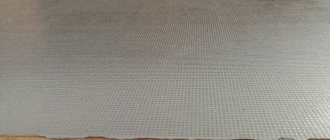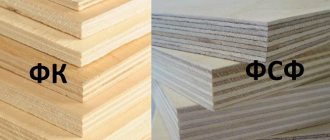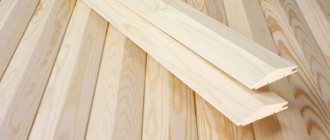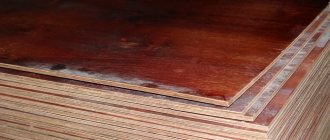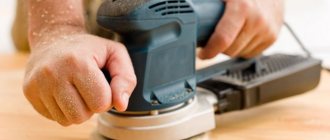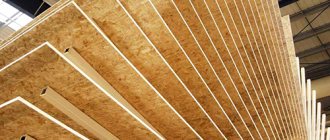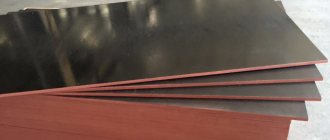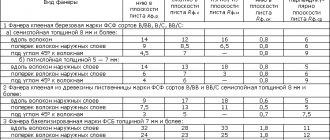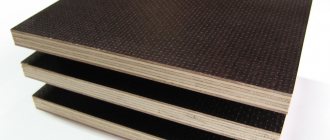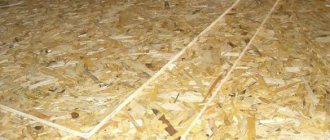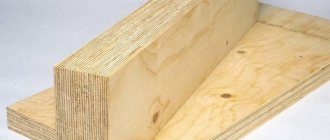Bakelite - marine grade or bakelite - plywood is a composite building material. It consists of rigid slabs consisting of several layers of wood veneer impregnated with special phenol-formaldehyde resins.
In terms of density and properties, this polymer composition is similar to amber or ebonite. Plywood is made by bonding layers of veneer together under high pressure . The finished material has high strength, moisture-repellent qualities, and exhibits excellent wear resistance.
This allows it to be used in various industries.
Brands and varieties
In the production of bakelite plywood, birch or pine veneer is used. Depending on the composition of the resins and impregnation methods, there are several types of marked finished material:
- FBS. Binding resins have alcohol-soluble bases. Impregnation is carried out using the complete immersion method. The top layers are made of first grade veneer. Plywood is very durable.
- FBS-1. Alcohol-soluble resins are applied to veneer sheets; the Bakelite content in the thickness of the plywood is less. The strength characteristics of this material are also lower.
- FBS-1-A. For plywood of this brand, some of the sheets are coated with resins, and only second-grade veneer is used. Least durable material.
- FBV. Plywood contains formaldehyde resins on a water-soluble basis. The upper layers are completely saturated with them, the inner ones are only coated. This type of plywood requires additional coating when used on external surfaces.
- FBV-1. The material consists of veneer sheets coated with water-soluble resins. It is not highly moisture resistant and is only suitable for interior decoration.
To improve moisture resistance, biostability, and to protect against the effects of chemical agents, the surface of bakelite plywood is laminated on one or both sides. The canvas becomes smooth. The “smooth-mesh” variety has a corrugated surface on one side. It is used where an anti-slip effect is required.
Specifications
Bakelite plywood has a characteristic dark reddish-brown hue. The finished material must comply with GOST 11539-83 standards. Its variety and brand are pressed by the manufacturer onto sheets along with the logo.
Standard sizes of bakelite plywood sheets:
- 5770×1250 mm;
- 2850×1250 mm;
- 2500×1250 mm;
- 2440×1220 mm;
- 1500×3000 mm
The thickness of the slabs ranges from 4 to 30 mm.
The density of 1 m³ of material is about 1200 kg. The weight of one sheet depends on the thickness of the slabs: 7 mm - about 25 kg, 27 mm - almost 85 kg.
- Static bending strength of plywood: 78.5 MPa.
- Ultimate tensile strength: about 73.5 MPa.
- The strength of the material exceeds the densest wood, approaching low-alloy steel.
Bakelite plywood exhibits good fire resistance: it can withstand temperatures up to +350 °C, does not support open combustion, charring under the influence of flame.
The material is resistant to corrosion, does not rot, does not deform, does not react with aggressive chemicals, and has dielectric properties.
Bakelite plywood can be used at ambient temperatures from –50 to +50 °C. The material retains its technical properties for up to 15 years.
Advantages and disadvantages
Bakelite composite has many advantages over other construction and finishing materials, combining the properties of natural wood and high-strength plastic:
- versatility: due to high strength, water resistance and fire resistance, it can be used in many industries;
- during operation it is not damaged by harmful chemical compounds: alkalis, fuels and lubricants, kerosene, alcohol;
- environmental safety: does not emit toxic impurities into the air, can be used in the interior decoration of residential premises;
- aesthetics, plywood does not require additional finishing, except in special cases;
- much lighter than steel and other materials of similar strength and wear resistance.
Bakelite plywood has few disadvantages, and they are all relative. These include:
- high specific gravity compared to other composites containing wood. Furniture and decoration made from it will put pressure on the supports - this must be taken into account when using;
- high price is the main disadvantage. The cost of one thin sheet of grade FBS-1 is at least 2,300 rubles, FBS - from 3,500 rubles and more. Such types of work using it, such as disposable formwork, become simply impractical.
Stages and features of production
Bakelite was first used in production in the first half of the 20th century. This polymer, invented by the American chemist Hendrik Baekeland, contained formaldehyde, phenol and an alkaline binder.
The polymer bonded firmly with the wood, giving it the necessary strength, moisture resistance, the ability to withstand open fire and other valuable qualities.
The structure of the fibers changed so much in the same composition with varnish that it was proposed to separate the finished material into a separate type - delta wood.
The production of bakelite plywood includes several stages:
- immersing the prepared veneer in containers with resin or coating it with a plasticizer on both sides;
- laying the impregnated sheets in a stack in such a way that the fibers of each layer are perpendicular to each other;
- pressing in chambers at a temperature of +270 °C under a pressure of 4 MPa;
- cooling;
- additional surface treatment: grinding, lamination;
- cutting and cutting slabs according to specified parameters.
Application
The physical and technical parameters of baked plywood are exceptional. The scope of its application is wide:
- Building sector. The material is used to build floating docks, sluices, water seals, and it is used for reusable formwork, wall partitions, and canopies. Light buildings, storage rooms, and garden houses are erected from bakelite plywood . In regions with warm climates, walls of residential buildings are built from it. Can be used for interior decoration of residential premises - ceilings, walls and floors. Bakelite material is a reasonable choice in hot, humid climates, in regions with frequent precipitation and large seasonal temperature changes.
- Mechanical engineering and automotive industry. The slabs are used to construct cabins, vans, floors, and are used for interior lining of car interiors and various mechanisms.
- Shipbuilding. It is not for nothing that this type of plywood is also called marine . Bakelite, which is impregnated with veneer, can withstand prolonged exposure to salt and fresh water. The material is used for covering ship decks, building boats and light boats.
- Plywood is well suited for making stands, decorations, technical models, and various visual aids.
What does the price depend on?
The cost of the finished material consists of many parameters. Among them:
- Plywood brand. Alcohol-soluble resins used in FBS grades are more expensive. Birch veneer in slabs is also highly valued. The FBS-1-A and FBV-1 varieties are cheaper than the others, where they use second-grade wood, coating it rather than impregnating it with bakelite.
- Sheet format. The cost of plywood directly depends on the thickness and size. Canvases of 27, 30 mm having such parameters will cost more.
- Manufacturer country. Russian-made material will differ in price from Chinese plywood, which is the cheapest possible.
| Size | Price per sheet (RUB) |
| 2440x1220x7 | 2085 — 2710 |
| 2440x1220x10 | 2975 — 3840 |
| 2440x1220x12 | 3570 — 4590 |
| 2440x1220x15 | 4465 — 5680 |
| 2440x1220x18 | 5360 — 6780 |
| 2440x1220x21 | 6250 — 7910 |
Calculation of the final cost must be done taking into account the required qualities of the material . For interior decoration of room walls, thin sheets with moderate moisture resistance and resistance to impact loads may be suitable. For outdoor work or building a boat yourself, it is better to choose high-quality thick slabs to ensure maximum service life.
Bakelite plywood: description, characteristics, properties and application
Bakelite plywood is also called bakelite or marine plywood. Durable material has a multi-layer structure. The main raw material for its production is birch wood. The layers or veneer of this tree are firmly bonded together with resins and subsequent heat treatment. Marine plywood is distinguished by such properties as reliability, high strength and wear resistance.
Bakelite plywood acquires special properties as a result of treatment with bakelite varnish, from which it gets its name. Marine plywood can withstand temperatures from +50 to -50 degrees, while it is not susceptible to mold or mildew.
It can also be used even in tropical climates with high humidity levels. Moreover, its useful life is 15 years or more. This type of plywood will be described in detail below.
The article talks in detail about the material and its areas of application, adds a couple of useful videos on the topic, and also offers the reader interesting material for downloading.
What is bakelite plywood?
Properties and technical specifications
You can distinguish bakelized plywood from regular plywood by color: it is slightly darker, with a red-brown tint. Standard material parameters:
- Dimensions - 5700x1250 mm, 2850x1250, 2500x1250 mm, 2440x1220 mm.
- Thickness - 7, 10, 12, 15, 18, 21, 24, 27 mm.
- Material density - 1200 kg/m3.
- Tensile strength along the fibers is 73.5 MPa.
- Static bending strength – 78.5 MPa.
- Standard parameters of laminated plywood are 1220x2440 mm, 1250x2500 mm, 1500x3000 mm.
- Sheet thickness: 4, 6, 9, 12, 15, 18, 21, 24, 27, 30 mm.
- Width of veneer strips: not less than 200 mm. For the FBS brand – at least 400 mm.
Conclusion
Bakelite plywood, as we have found out, has high performance qualities, thanks to which it can be used in the most critical structures. The only thing you should take into account is that many of its qualities depend on the type of adhesive composition and processing features. Therefore, the choice of material must be approached wisely.
You can get more information from the video in this article. If any of your questions remain unanswered after reading the material, you can ask them in the comments.
What is bakelite plywood, its features and application
Bakelite (bakelized, “marine”) plywood is a multilayer building material made from birch veneer, bonded together using special phenol-formaldehyde resins with thermal activity. It has particularly high strength and wear resistance. This type of plywood acquires such exceptional qualities comparable to it as a result of special processing, which consists of impregnating the internal and external layers of veneer with bakelite varnish. The material obtained by this method has improved moisture resistance and high strength characteristics.
Plywood, which is often called “marine”, can be used in temperatures ranging from -50 to +50 C⁰. It does not rot, is not affected by fungi and bacteria, which allows it to be used in countries with hot climates (tropics and subtropics) and in coastal areas. Duration of operation is about 15 years.
Modern industry produces two brands of bakelite plywood: FBS and FBV, made on the basis of water-soluble resins. In turn, they are also divided into several main types: FBS, FBS - 1, FBS - 1A, FBV, FBV -1.
At the same time, the letter “A” in the marking of the material indicates the possibility of its use for interior work, “B” - the content of water-soluble resins in the plywood, and “C” - alcohol-soluble resins.
To achieve better strength and resistance to various types of mechanical, bacteriological and chemical influences, bakelite plywood is laminated.
The technical description and scope of application of bakelite plywood of the above grades are presented in the table:
| Brand | Description | Use Cases |
| FBS | All layers of veneer are impregnated with an alcohol-soluble resin based on phenol-formaldehyde. The outer layers are made from 1st grade veneer, and the inner layers are made from 2nd grade. Has high strength. Not flammable. | Design of cars, machines, ships, construction. Interior work. |
| FBS-1 | The strength of the material is lower. The resin is applied to all layers of veneer using the coating method. | Design of cars, machines, ships, construction. Internal work. |
| FBS-1A | All veneer layers, except the transverse ones, are coated with alcohol-soluble resin. Made entirely of grade 2 veneer. It has the lowest price and poor resistance to difficult weather conditions. | Interior work. |
| FBV | The water-soluble resin impregnates the outer layers of veneer, the inner ones are only coated. | Structural parts of machines and units in mechanical engineering. Use in outdoor conditions only after additional protection with paints and varnishes. |
| FBV -1 | All layers of veneer are coated with water-soluble formaldehyde resin. | Structural parts of machines and units in mechanical engineering. Use in outdoor conditions only after additional protection with paints and varnishes. |
Laminated bakelite plywood has a very smooth, glossy, hard surface. It is easy to care for, very durable and non-toxic.
It can be smooth on both sides or smooth on one side (mesh on the other).
A variety of the latter type (with a smooth mesh surface), called transport plywood, is used for the manufacture of anti-slip floors in the bodies of trucks.
Photo of bakelite plywood
Properties and technical specifications
You can distinguish bakelized plywood from regular plywood by color: it is slightly darker, with a red-brown tint.
Standard material parameters:
- Dimensions - 5700x1250 mm, 2850x1250, 2500x1250 mm, 2440x1220 mm.
- Thickness - 7, 10, 12, 15, 18, 21, 24, 27 mm.
- Material density - 1200 kg/m3.
- Tensile strength along the fibers is 73.5 MPa.
- Static bending strength – 78.5 MPa.
- Standard parameters of laminated plywood are 1220x2440 mm, 1250x2500 mm, 1500x3000 mm.
- Sheet thickness: 4, 6, 9, 12, 15, 18, 21, 24, 27, 30 mm.
- Width of veneer strips: not less than 200 mm. For the FBS brand – at least 400 mm.
One of the main advantages of bakelite plywood is its high strength, comparable to the strength of high-quality alloy steel. In addition, this material has other positive properties.
These include:
- High moisture resistance.
- Durability.
- Not subject to delamination during operation.
- Fire resistance. When the temperature is significantly exceeded (up to 350 C⁰), it becomes charred and does not support combustion. At the same time, the smoke generated during the smoldering process does not have a pronounced suffocating or toxic effect.
- Good resistance to bacteriological and chemical influences (not afraid of kerosene, sea water, weak acids, alkalis, gasoline, not damaged by fungus and mold).
- Environmental Safety.
That is, rating this material on a five-point scale, you can assign it “fives” in the areas of quality, reliability and practicality. In addition, it deserves an “excellent” rating for its simplicity and ease of use. The only thing that can slightly reduce points when evaluating bakelite plywood is its high cost.
Stages and features of production
The “bakelite” component used in the production of bakelite plywood was invented at the beginning of the 20th century by the American chemist, Leo Hendrik Baekeland, who obtained it from phenol and formaldehyde with the addition of alkaline-type condensing substances.
This polymer was the first plastic capable of operating at high temperatures. In addition, it had dielectric properties and was not soluble in water. Bakelite then began to be used as one of the main components for the production of special grade plywood. It was made using birch veneer, impregnated or coated with phenol-formaldehyde resins.
Today, the production technology of this material consists of several stages:
- Depending on the grade and brand of the final product, the veneer is completely immersed in resin or lubricated with it on both sides.
- The veneer layers are laid perpendicular to each other and pressed at a pressure of up to 4 MPa.
- While under pressure in the press, the plywood is cooled to the required temperature, after which, if necessary, it undergoes additional processing (lamination, sanding, etc.) and cut to specified standards.
Due to its exceptional physical and technical parameters, bakelite plywood is used in various industrial sectors, including:
- Construction. It is used to make floating docks, water seals and sluices, reusable formwork, as well as canopies, partitions and other small and large architectural forms in combination with other types of plywood, such as flexible or veneered.
- Automotive industry. This material is used for covering the floors of vehicles for various purposes; car vans, etc. are made from it.
- Construction of ships. It is used for deck plating and the manufacture of sea containers.
- Mechanical engineering. This type of plywood is used to make the internal parts of various mechanized structures.
What is bakelite plywood
Bakelite moisture-resistant plywood is a building material unique in its properties.
It is made under high temperature and pressure from birch or pine veneer and coated with an alcohol solution of phenol-formaldehyde resin (bakelite varnish).
It differs from other types of plywood in its increased resistance to moisture, fire, chemicals, and temperature changes. During operation, it fully retains its properties for 10 years, which determines its widespread use in various industries.
Production and labeling of bakelite plywood
The process of manufacturing sheets of this material, which has many names (delta wood, buck plywood, marine, marine, ship, chipboard-10, bakelized, wood-laminated plastic), includes the stages:
- impregnation of veneer with cresol- or phenol-formaldehyde resin;
- pressing and gluing plates at a pressure of 6 atm. (607.95 kPa) and temperature 270°C;
- coating of finished sheets with bakelite varnish.
On the building materials market, backflywood is represented by the brands FBV, FBV 1, FBS, FBS 1, FBS A, FBS 1A.
The marking reflects the following points:
- * F – plywood;
- * B – bakelite coating;
- * B – water-soluble resin was used in the process of veneer impregnation;
- * C – veneer is impregnated with alcohol-soluble resin;
- * 1 – all layers of veneer are impregnated;
- * no number – only the outer plates are impregnated;
- * A – plywood is intended for use in the automotive industry.
Bakelized plywood brands
| Plywood grades | Brand characteristics | Application area |
| FBS | The outer layers of plywood are impregnated with phenol-formaldehyde alcohol-soluble resin. No resin is applied to the inner layers | For the manufacture of structures in mechanical engineering, automotive industry, construction and shipbuilding, operating in atmospheric conditions |
| FBS1 | Phenol-formaldehyde alcohol-soluble resin is applied to the outer and inner layers of plywood | — |
| FBV | The outer layers of plywood are impregnated with phenol-formaldehyde water-soluble resin. Resin is applied to the inner layers of plywood | For the manufacture of internal structures used in mechanical engineering, automotive and shipbuilding. When protecting external surfaces with paint and varnish coatings |
| FBV1 | Phenol-formaldehyde water-soluble resin is applied to the outer and inner layers | For the manufacture of structures operating in atmospheric conditions |
| FBS-A | Phenol-formaldehyde alcohol-soluble resin is applied to the outer and inner layers of plywood | — |
| FBS1 - A | Phenol-formaldehyde is applied to the outer and inner layers of plywood (except for two transverse layers located symmetrically from the central one). | For the manufacture of internal structures used in the automotive industry |
Thus, FBS bakelite plywood is a building material made from veneer, the outer layers of which are impregnated with alcohol-soluble resin. It is not suitable for car production.
Properties of plywood with bakelite coating
The price of bakelized plywood is quite high compared to its other varieties (from 1,900 rubles per sheet), but it is fully justified by the characteristics of this material:
- density 1200 kg/cubic. m, which is comparable to the density of crushed stone and expanded clay concrete (for example: the density of birch wood is 650 kg/cub. m, ash wood is 750 kg/cub. m);
- high resistance to weak acids, fuels and lubricants (gasoline, etc.), alkalis, water (including sea water);
- lack of ignition, at ambient temperatures above 350°C, the back plywood begins to char, but does not ignite;
- operating temperature – from –50°С to 50°С;
- does not corrode or develop fungus;
- thanks to the colossal wear resistance, the service life can reach 15 years;
- environmental friendliness, because No toxic substances are used in the production process.
The woodworking industry produces back plywood sheets of various sizes in square and rectangular shapes. The length of one sheet is from 1220 to 5700 mm, width - from 1220 to 1550 mm. Thickness varies from 5 to 40 mm.
Physical and mechanical properties of bakelized plywood
| Indicator name | Plywood thickness, mm | Value for stamps | |||
| FBS increased strength | FBS | FBV, FBS-A | FBS1, FBV1, FBS1-A | ||
| 1.Tensile strength along the fibers of the outer layers of plywood, MPa, not less | 5;7 | 88 | 88 | 78,5 | 59 |
| 10; 12 | 73,5 | 73,5 | — | — | |
| 14;16;18 | 68,5 | 68,5 | — | — | |
| 2. Ultimate strength during static bending, MPa, not less | |||||
| across the fibers of the outer layers | 7 | 78,5 | 78,5 | 63,5 | — |
| 10;12 | 80 | 78,5 | 68,5 | — | |
| 14; 16; 18 | 90 | 88,2 | 78,5 | — | |
| along the fibers of the outer layers | 10; 12 | 117,5 | 117,5 | 108 | 88 |
| 14;16;18 | 108 | 108 | 98 | 78,5 | |
| 3. Ultimate strength when chipping along the adhesive layer after boiling in water for 1 hour, MPa, not less | 5-18 | 1,76 | 1,76 | 1,47 | 1,47 |
| 4. Humidity, % | 5-7 | 6 + 2 | |||
| 10-18 | 8 + 2 | ||||
| 5. Density kg/m2, no more | 5-18 | 1200 |
The use of bakelized plywood during the war
People were able to learn and fully appreciate what bakelite plywood is during the Great Patriotic War.
In the 1940s, there was an acute issue of shortage of structural alloys for assembling military aircraft, and delta wood - the invention of Yakov Avrasin - became indispensable.
From it, under the leadership of Vladimir Gorbunov, high-speed fighters LaGG-1 and LaGG-3 were built, and parts of the wings and fuselage were made for the Il and Yak aircraft.
The idea was immediately picked up by the Japanese. Legends about plywood planes in which Japanese kamikazes attacked the American naval base at Pearl Harbor have a very real basis.
Introduction
Plywood is a multi-layer material made from veneer. The number of veneer layers is always odd, that is, there are three-layer, five-layer and multi-layer. There is plywood that can have 23 layers. To maximize strength, the layers are always arranged perpendicularly, although, of course, there may be options with a parallel arrangement, but this is a very rare case and should not be taken into account. Plywood differs in its strength from other wood panels, such as chipboard.
Plywood is processed and sawed without the use of any special industrial tools; you can even use an ordinary household jigsaw and simple wood saws.
